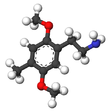
| |||
| |||
| Names | |||
|---|---|---|---|
| Preferred IUPAC name
2-(2,5-Dimethoxy-4-methylphenyl)ethan-1-amine | |||
Other names
| |||
| Identifiers | |||
3D model (JSmol)
|
|||
| ChEMBL | |||
| ChemSpider | |||
PubChem CID
|
|||
| UNII | |||
CompTox Dashboard (EPA)
|
|||
| |||
| |||
| Properties | |||
| C11H17NO2 | |||
| Molar mass | 195.262 g·mol−1 | ||
| Melting point | 213 to 214 °C (415 to 417 °F; 486 to 487 K) (hydrochloride) | ||
| Pharmacology | |||
| Legal status |
| ||
Except where otherwise noted, data are given for materials in their standard state (at 25 °C [77 °F], 100 kPa).
| |||
2C-D (2,5-dimethoxy-4-methylphenethylamine or 2C-M) is a psychedelic drug of the 2C family that is sometimes used as an entheogen. It was first synthesized in 1970 by a team from the Texas Research Institute of Mental Sciences,[1] and its activity was subsequently investigated in humans by Alexander Shulgin. In his book PiHKAL, Shulgin lists the dosage range as being from 20 to 60 mg.[2] Lower doses of 10 mg or less have been explored for microdosing.[3]
Not much information is known about the toxicity of 2C-D, as no major studies have been conducted. According to Shulgin, the effects of 2C-D typically last for 4–6 hours.[2] Shulgin himself referred to this substance as a “pharmacological tofu,” meaning that when mixed with other substances, it can extend or potentiate their effects without coloring the experience too much, in a manner similar to how tofu absorbs the flavors of sauces or spices it is cooked with. Hanscarl Leuner, working in Germany, explored the use of 2C-D under the name LE-25 in psychotherapeutic research.[citation needed]
- ^ Ho BT, Tansey LW, Balster RL, An R, McIsaac WM, Harris RT (January 1970). "Amphetamine analogs. II. Methylated phenethylamines". Journal of Medicinal Chemistry. 13 (1): 134–5. doi:10.1021/jm00295a034. PMID 5412084.
- ^ a b 2C-D Entry in PiHKAL
- ^ Nez, Hosteen (2015). "Erowid 2C-D Vault : Smart Pills". www.erowid.org. Archived from the original on 2001-07-09. Retrieved 2022-01-09.

